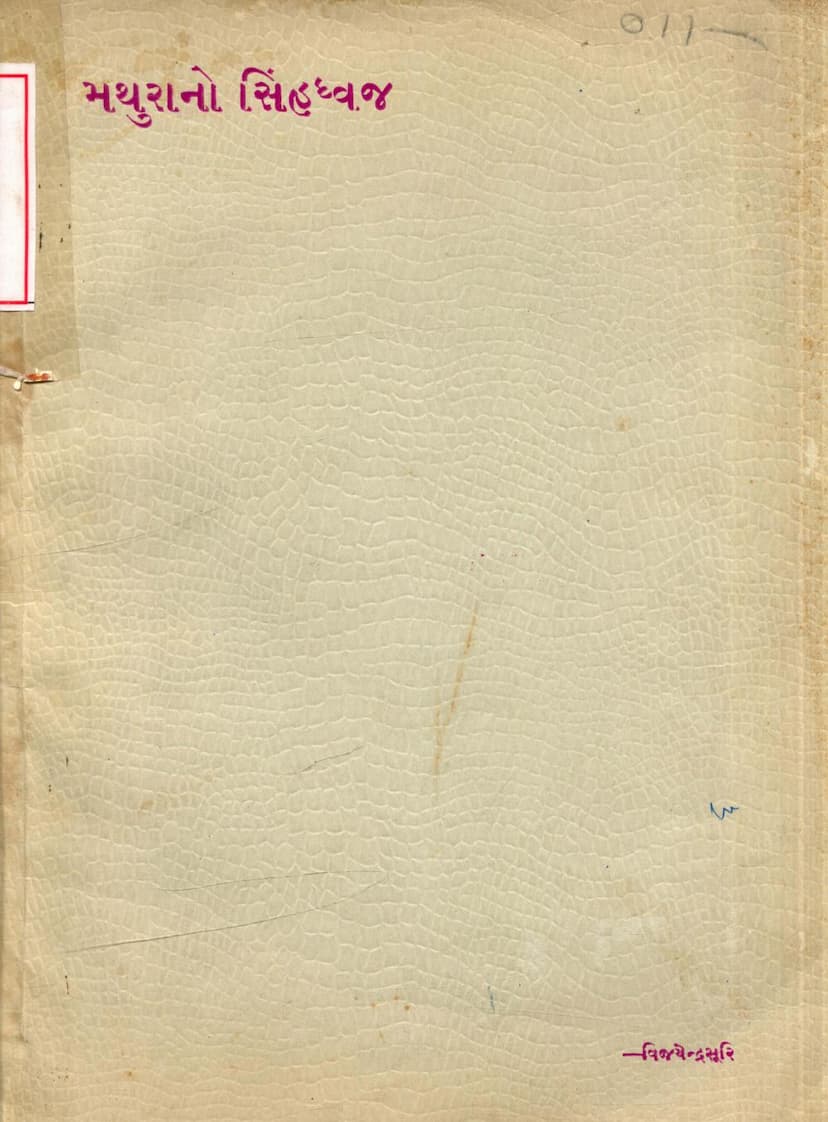Mathurano Sinhdhwaj
Added to library: September 2, 2025

Summary
Here's a comprehensive summary of the Jain text "Mathurano Sinhdhwaj" by Acharya Vijayendrasuri, based on the provided pages:
Book Title: Mathurano Sinhdhwaj (The Lion Capital of Mathura) Author: Acharya Shri Vijayendrasuri Publisher: Yashovijay Granthmala, Bhavnagar Publication Year: Samvat 1994 (1931 CE)
Overview:
"Mathurano Sinhdhwaj" is a scholarly work by the Jain Acharya Vijayendrasuri, focusing on a significant artifact discovered in Mathura, known as the Lion Capital. The book aims to provide a thorough historical and critical analysis of this artifact, its inscription, and its cultural context, particularly in relation to Jainism and Buddhism.
Key Themes and Arguments:
-
The Significance of Mathura: The book highlights Mathura as a city of immense historical and cultural importance in ancient India. It was a center for Jainism, with its prominence traced back to the time of the 7th Tirthankara, Shri Suparshvanath, and flourished further during the eras of Parshvanath and Mahavir. Later, it also became a significant site for Vedic and Buddhist cultures.
-
Challenging Prevailing Notions: Acharya Vijayendrasuri's work is presented as a meticulous and unbiased examination of historical evidence. The publisher's note emphasizes the Acharya's broad understanding of Buddhist literature and his neutral approach, even when dealing with subjects related to other religious traditions. The book is intended to demonstrate that despite the Acharya being a Jain monk, he can present historical truths without sectarian bias.
-
The Mathura Lion Capital Inscription:
- Discovery and Location: The Lion Capital inscription was discovered in 1869 CE by the renowned Gujarati scholar H. Bhagvanlal Indrji. It was found embedded in the steps of the Shitaladevi temple. After Bhagvanlal Indrji's death, the artifact was transferred to the British Museum in London, where it currently resides.
- Physical Description: The Lion Capital is described as being 1 foot 7 inches high and 2 feet 8 inches wide. It features two lions seated back-to-back, with a large hole passing through them, connecting to an internal cavity.
- The Inscription's Script and Language: The inscription is written in the Kharoshthi script. The text notes the difficulty in deciphering the script due to the absence of vowel length distinction and the complex arrangement of the writing across different parts of the sculpture.
-
Debate on the Lion Capital's Affiliation:
- The Author's Initial Inclination: Acharya Vijayendrasuri initially believed the Lion Capital belonged to the Jains, which would have been a matter of great pride. However, after careful re-examination and consultation with Indian and European scholars, he concluded that the inscription is definitively Buddhist.
- Scholarly Consensus: The book presents a significant section of correspondence (Section III: Opinions) featuring letters from prominent historians and archaeologists of the time. These include F.W. Thomas, Prof. Rapson, Sir John Marshall, Dr. Sten Konow, Dr. D. R. Bhandarkar, Dr. R. C. Majumdar, Dr. B. C. Law, Sir J. H. Marshall, Dr. E. J. Rapson, Dr. H. von Glasenapp, Dr. Hiranand Shastri, Dr. V. S. Agrawala, and others. The overwhelming consensus among these experts is that the Lion Capital inscription is Buddhist and not Jain.
- Arguments for Buddhist Affiliation: The inscription explicitly mentions Buddha Sakyamuni, the veneration of the Buddha, Dharma, and Sangha, and refers to the Sarvastivada and Mahasamghika schools of Buddhism. The very establishment of the pillar was for the relics of Buddha.
- Refutation of Misconceptions: The book critically analyzes and refutes earlier or alternative interpretations, particularly those presented in the "Prachin Bharatvarsh" (Ancient India) publication by Dr. Shah. Acharya Vijayendrasuri points out factual inaccuracies and speculative claims in Dr. Shah's work regarding the dating of pillars, the identity of rulers, and the interpretation of symbols like the Swastika. He highlights that Dr. Shah's assertions about the Lion Capital, Sanchi Stupa, and Bharhut Stupa being Jain are unsubstantiated and contradict the established scholarly consensus.
-
Critique of "Prachin Bharatvarsh": A substantial portion of the "Review" section (Section II) is dedicated to a detailed critique of the work "Prachin Bharatvarsh." Acharya Vijayendrasuri meticulously deconstructs the author's (Dr. Shah's) interpretations, pointing out:
- Misidentification of historical figures and their relationships (e.g., conflating father-in-law with father, and brother with nephew).
- Fabrication of historical facts and names.
- Incorrect understanding of scripts (confusing Brahmi with Kharoshthi).
- Misinterpretation of symbols (e.g., over-attributing the Swastika to Jainism).
- Erroneous historical timelines and claims about political figures like Bhumaka and Nahapana.
- The critique emphasizes the importance of relying on established evidence and scholarly consensus rather than unsubstantiated speculation.
-
Purpose and Contribution: The book aims to correct historical misconceptions and provide a factually accurate account of the Mathura Lion Capital. It demonstrates the author's commitment to historical truth, even when it challenges pre-conceived notions within his own community. The publisher expresses pride in presenting this work, highlighting it as a testament to the Acharya's intellectual integrity and his contribution to Indian historiography.
In essence, "Mathurano Sinhdhwaj" is a scholarly treatise that meticulously examines the Mathura Lion Capital inscription. Through critical analysis and by presenting the opinions of leading international scholars, Acharya Vijayendrasuri firmly establishes the Buddhist identity of the artifact and its inscription, while also critiquing alternative, less substantiated interpretations.